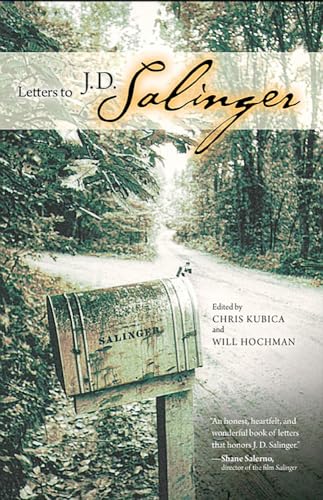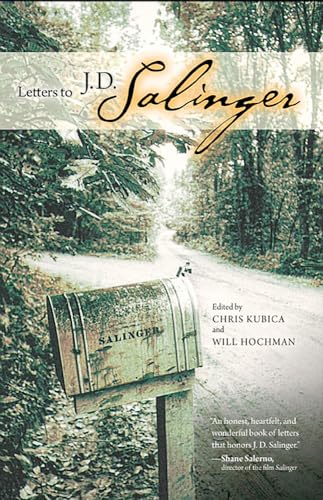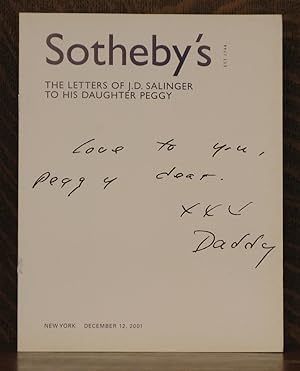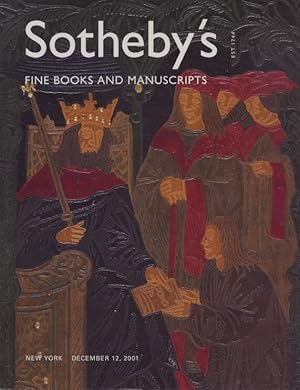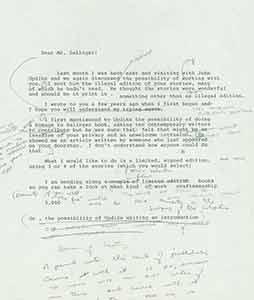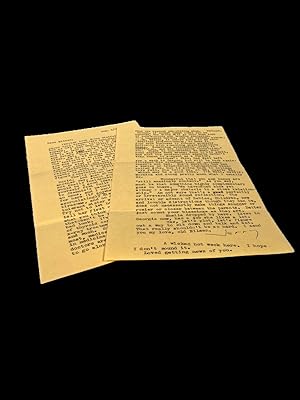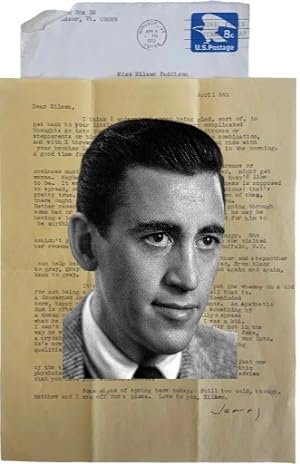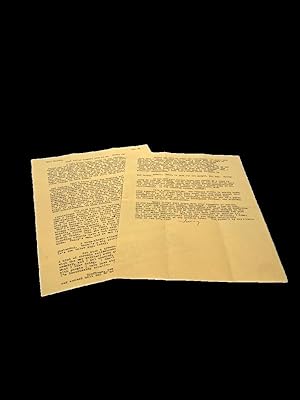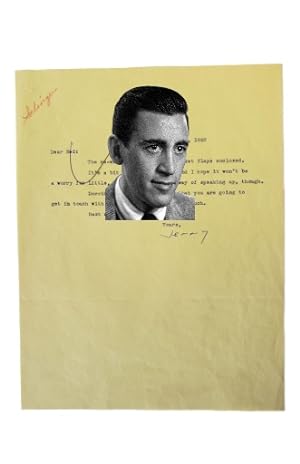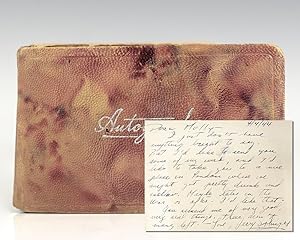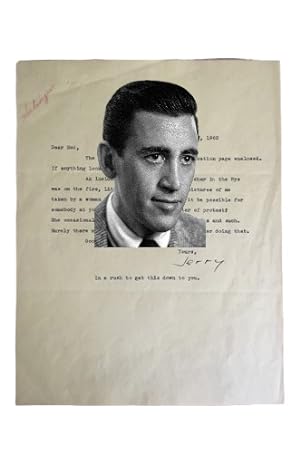Letters J D Salinger (44 results)
Product Type
- All Product Types
- Books (36)
- Magazines & Periodicals
- Comics
- Sheet Music
- Art, Prints & Posters
- Photographs
- Maps
-
Manuscripts &
Paper Collectibles (8)
Condition
Binding
Collectible Attributes
- First Edition (6)
- Signed (8)
- Dust Jacket (11)
- Seller-Supplied Images (13)
- Not Printed On Demand
Free Shipping
Seller Location
Seller Rating
-
Letters to J. D. Salinger
Published by University of Wisconsin Press, 2002
ISBN 10: 0299178005ISBN 13: 9780299178000
Seller: Better World Books, Mishawaka, IN, U.S.A.
Book
Condition: Very Good. Used book that is in excellent condition. May show signs of wear or have minor defects.
More buying choices from other sellers on AbeBooks
New offers from £ 17.54
Used offers from £ 4.90
Also find Hardcover First Edition
-
Letters to J. D. Salinger Format: Paperback
Published by University of Chicago press, 2014
ISBN 10: 0299178048ISBN 13: 9780299178048
Seller: INDOO, Avenel, NJ, U.S.A.
Book
Condition: New. Brand New.
More buying choices from other sellers on AbeBooks
New offers from £ 14.71
Used offers from £ 16.92
Also find Softcover
-
SOTHEBY'S, THE LETTERS OF J. D. SALINGER TO HIS DAUGHTER PEGGY, NEW YORK, DECEMBER 12, 2001
Published by NY: Sotheby's, 2001
Seller: Andre Strong Bookseller, Blue Hill, ME, U.S.A.
First Edition
Paperback. Condition: Very Good. First edition. 8 x 11 in. Auction catalogue with B&W photos. A single lot. Results not included. Condition is VERY GOOD ; minor edge wear, covers very clean, binding tight, text spotless. Antiques. Stax.
-
Sothebys Dec 2001 Fine Books & Manuscripts inc Americana & J.D. Salinger Letters
Seller: thecatalogstarcom Ltd, Westbury, United Kingdom
Condition: Good. Sotheby's - New York, Sale title - Fine Books and Manuscripts including Americana, Date - 12th December 2001, No. of lots - 417, No. of pages - 380, Illustrated in colour and black & white, including 5 page supplement - 1 lot - The Letters of J.D. Salinger to his Daughter Peggy Weight: 1101g We use registered airmail for all parcels which are sent out from our depot in India. Parcels usually take 1 - 2 weeks to arrive at your selected destination. All parcels are shipped within 1 working day of payment being received.
-
Draft of typed letter of solicitation from Herb Yellin of Lord John Press to J.D. Salinger.
Published by Northridge, CA: Herb Yellin, [1975]., 1975
Seller: Wittenborn Art Books, San Francisco, CA, U.S.A.
Manuscript / Paper Collectible
Condition: Good. Draft of typed letter of solicitation to J.D. Salinger. 8.5 x 11 inches. 1 pp. Very good. Undated. From the estate of Herb Yellin (1935 - 2014), the publisher of the Lord John Press.
-
J.D. Salinger Typed Letter Signed to Publishers about "Franny and Zooey," May 27, 1961
Manuscript / Paper Collectible Signed
A revealing letter signed by J.D. Salinger, all relating to the impending publication of Franny and Zooey. Salinger wrote this letter just over a month before Franny and Zooey was published, as he received the corrected proofs. 1 page, typed and signed in his hand in full, "J.D. Salinger" to his publisher. In it, he attempts to convince Little, Brown that the most authentic running heads for "Franny" and "Zooey," would be with the individual titles, rather than the full Franny and Zooey. He argues in true Salinger fashion, "I really can't see, at all, why an appropriate running head for a short story need appear to be anything except what it is." In 1955 and 1957, "Franny" and then "Zooey," two stories about the youngest members of the Glass family, were released separately in the New Yorker. In July of 1961 they became the two-part book, Franny and Zooey. Through the publication process, Salinger fought to keep creative control. Since Little, Brown first championed Salinger's artistic vision ten years earlier by publishing The Catcher in the Rye, the author placed his faith in them. However, as he writes here, Little-Brown's general approach in this affair of the Running Heads "doesn't exactly inspire confidence." Their competing visions did not always mesh. He writes, "I find all the suggested aesthetic reasons" for running Franny and Zooey as a head over the story FRANNY "very hard to take." Salinger relentlessly pursued authenticity. As he explains to Miss Rackliffe, the stories must have their appropriate title, rather than bowing to an incorrect one for aesthetic reasons: "Your department now agrees that Franny is the appropriate running head for the story FRANNY, and that Zooey is the appropriate one for the story ZOOEY, but I gather you all feel that those single short titles drags the page badly or unnicely." However, he discourages the "drastic remedy" of "[e]ntirely deleting the running heads." He goes on to reference Nine Stories, which Little-Brown published. "Surely the word Teddy looks perfectly reasonable carried as a running head. It just is what it is: the title of the story." Comes with envelope. An important Salinger letter that shows how he tried to protect his literary integrity throughout the publication process.
-
J.D. Salinger Letter Signed on Relationships and his Continued Writing After His Last Publication
Manuscript / Paper Collectible Signed
Salinger, J.D. American author of The Catcher in the Rye. Typed letter signed "Jerry". 2 pages. August 4, 1979. To Eileen Paddison, a close friend and aspiring writer who maintained a correspondence with Salinger for over 15 years. A letter detailing his distrust of "the typical AMA-abiding mind" (by which he means non-homeopathic western medicine doctors) and the difficulty of being a good sibling, "small hell for a tolerant sister with a telephone in the house." Both for the anti-establishment content, and the interplay of sibling relations content, this letter is richly exemplative of Salinger's attitudes as a person and as an author. Most fascinating however, is Salinger's admission in this letter that he is "working", (by which he means that he continues to write), although his last novella, "Hapworth 16, 1924, had been published 14 years earlier, and no more of his fiction would ever be published. An encouraging and personal letter by J.D. Salinger, one of America's great authors. In 1972, a boarding school student with family problems, much like Holden Caulfield, wrote to the reclusive author of The Catcher in the Rye,and then something almost unheard of happened-he wrote back. Seven years later, the correspondence had blossomed into a friendship, with the author offering sage fatherly advice to Eileen Paddison. Of particular interest in any Salinger letter is the presence of sibling relationship content, which was a chief focus of his fiction. This letter is particularly rich in that regard, as Salinger provides his sympathetic yet comically rich commentary, "I don't think it would be a good idea, at all, if you let yourself feel Guilt you're your responses to Jeannie's nature and lot. Guilt's such an onus, and I can't see that it's called for here (if anywhere) anyway. She sounds excruciatingly disorderly, irresponsible, tiresome, and no doubt small hell on any tolerant sister with a telephone in the house." In contrast, he offers his sympathy and encouragement to news of her brother David's thyroid cancer. In The Catcher in the Rye, the underlying impetus for Holden's mental break was the cancer death of his brother Allie. The letter is also unusual for having personal content about Salinger's life and his family, which the author generally kept a jealously guarded secret. His son Matthew has "finished his freshman year of college" and his daughter Peggy "has had a series of tread-water high-paying blue-collar jobs, but is going back to college this fall, she tells me, at 23, nearly 24, which may be a good idea." Twice divorced and living alone at the time of this letter, Salinger offers some advice probably gleaned from his own experience. "The arrival or advent of Babies, Children, new and lovable distractions though they can be, does not necessarily make things snugger or rosier or closer between the parents. Better just count your blessings as they are." After The Catcher in the Rye catapulted Salinger to fame in 1951, J.D. Salinger retreated from New York City to a cabin in rural New Hampshire, and following a fraught series of interactions with the publishing industry which gradually eroded his trust, Salinger made the decision to never again publish his fiction. Over the years, theories abounded about whether Salinger had stopped writing, or whether a stockpile of stories would emerge some day. But since his death in 2010, at the age of 91, no such work has emerged. Despite confirmation from the Salinger family that his writing was preserved and will be published, potential publication dates have come and gone, leaving the public to wonder if we will ever see the product of this solitary genius mind. This letter, written during the mysterious and isolated period of Salinger's life, confirms that he was writing and doing so consistently, "I've been working and doing pretty much what I usually do." Also with content on Salinger's famous distaste for the medical establishment. Salinger himself followed homeopathic and Eastern medicine, and it seemed to work for him, since he lived to be 91. The author's comments here are particularly biting, "How damnable are many, if not most, medical vogues. Yes, vogues. Fashions in medicine. What secondhanders nearly all doctors are! How ready and willing they are to go along with what's New. I do despise and fear the typical AMA-abiding mind." However, he feels about medicine in general, Salinger is hopeful and encouraging to his young woman correspondent about her own ambition, ".Oh Eileen, if you're going to go into Medicine professionally, do make it your grim business to concern yourself with something physiologically basic.There is undoubtedly so much that homo sapiens does wrong, does to his peril, and that the professional experts haven't even begun to suspect as a factor." A long, 2 page letter, on the author's usual goldenrod paper. Signed with the signature generally reserved only for friends, "Jerry" and followed by a postscript. Original typed mailing envelope bearing his PO Box address in Windsor, Vermont, the usual mailing address he preferred while writing from his home in Cornish, New Hampshire. A simultaneously sympathetic and acerbic letter from the literary king of such unlikely combinations, J.D. Salinger. In very good condition.
-
J.D. Salinger Letter Commiserating with a Boarding School Kid On Some of the Same Difficulties as Holden Caulfield
Manuscript / Paper Collectible Signed
Salinger, J.D. American author of The Catcher in the Rye. Typed Letter signed "Jerry". 1 page. April 5, [1972]. To Eileen Paddison, then a high school student living at boarding school, she would become a close friend and confidante of Salinger over the next several years. A striking letter in which the reclusive author admits he understands what she is going through, having escaped family problems through boarding school himself as a teenager, and lending his support her issues with family, "I think I understand about being glad, sort of, to get back to your little cell at school." It was Salinger's boarding school experience coupled with a fraught family life that formed the basis for his most acclaimed novel, The Catcher in the Rye,which also made him a lightning rod for a generation of young people who identified with his profound isolation. While Salinger received hundreds, if not thousands, of letters from teenagers who believed he alone would understand their problems, responsive letters from the enigmatic author are exceptionally rare, especially with such personal content. Salinger's description of Holden Caulfield, a thoughtful young man stuck in a confusing and materialistic world captured the minds of generation after generation. His fans and the press universally hounded him to reveal the true relationship between Holden Caulfield, and the author himself as a child. In reaction, Salinger became ever more reclusive, declaring publicly that no author should discuss the source of his inspiration, particularly not as they pertain to his personal life. Because of that, instances where the author describes any similarity between himself and Holden are extremely rare. Here, Salinger describes an unwillingness to go home from boarding school for vacation, which is exactly what caused Holden to roam the streets of New York City for several days alone, "I think I understand about being glad, sort of, to get back to your little cell at school. So many complicated thoughts go into that feeling, though. Not just divorce or stepparents or blah vacations, but so many things in combination, and with X thrown in." In another interesting parallel, Salinger imagines that the greatest relief about having to go home would be the opportunity to converse with a sibling late at night, as Holden did with his sister Phoebe, in the middle of the night. He writes in this letter, "At least, you had a pretty good ride with your brother Dave. Pitch black highway talk at three in the morning. A good time for it." Salinger offers his unique take on this young boarding school student's strained relationship with the adults in her home, something that he also dealt with personally in his life and through his character Holden. Particularly "your stepmother's indifference or coolness" and her father "having a lousy time" in "uncertain marital waters." Always conscious of the complexity of human relationships, Salinger writes, "I don't see how what you write of your father and stepmother can help being "contradictory". Relationships shift so, from black to gray, gray to black, gray to almost-white, etc. And again and again." And cautions her, "Better reserve any judgement of your Daddy." Something that Salinger apparently does not reserve his judgment on is the tendency of an adult to resort to judgment and name-calling at a child. His fictional narrators, in most instances, were young people, whom Salinger believed thought and behaved far more authentically than adults. Interestingly in this letter, Salinger's comments exclude himself from the definition of "adult": "It's stupid of any so-called adult to put the whammy on a kid for not being a Concerned American. Whatever the hell that is. A Concerned American is so often a politics- or civic-minded bore, happy or diverted only in shallow current events." This particular attack apparently touched such a chord with Salinger that he is led into describing some very personal childhood memories, and perhaps even the origin of Holden's perpetual war against adult "phonies." As Salinger recalls in crystalline prose here in this letter, "An Apathetic Bum is often not apathetic, at all, nor a bum, but something by a dozen other words or shadings none of which really express what he is. My father once called me a bum when I was a kid. I can't remember whether it bothered me or not. Surely not in the way he would have wanted it to bother me. I thought him a fake, a crybaby, a tyrant, and possibly the biggest bore I've ever run into." On the author's usual goldenrod paper, ending this full page letter with the signature generally reserved only for friends, "Jerry" in black ink. Original mailing envelope in type bearing his PO Box address in Windsor, Vermont, the usual mailing address he preferred while writing from his home in Cornish, New Hampshire. An extremely rare Salinger letter for the content it reveals about his childhood and about boarding school; the topic of his most famous novel, The Catcher in the Rye. In very good condition.
-
J.D. Salinger Letter Signed Commiserating with a Boarding School Kid: On Identity Crises, and other Holden-esque Adolescent Difficulties
Manuscript / Paper Collectible Signed
Salinger, J.D. American author of The Catcher in the Rye.Typed letter signed "Jerry" and with two hand-written pencil corrections. 2 pages. Dec. 23, 3 PM [1971]. To Eileen Paddison, a boarding-school girl and aspiring writer who struck up an unlikely lifelong friendship with the author, and over time became the recipient of some of his most personal confessions. A long and intriguing letter, in which the reclusive author admits he understands what she is going through, grappling with a mixed identity, and finding his escape in boarding school, "Boarding schools have a bad name, but they oddly suit some kinds of kids." It was Salinger's boarding school experience coupled with intrinsic alienation that formed the basis for his most acclaimed novel, The Catcher in the Rye. Also with content on his hatred of stealing and intense love of privacy-two factors which would dominate the second half of his life as Salinger withdrew from the limelight and aggressively punished infringement on his intellectual property. Salinger's letters to young Eileen Paddison express a kinship that exceeds every other correspondent, including romantic partners and family. I this letter, he is particularly open, and also elucidates how the similarity in their lives that led him to feel "a gigantic comfort" in her friendship. As well as both being boarding school kids, Salinger found it "extraordinary" that the two share the same unique combination of half-Irish, half-Jewish backgrounds. He posits whether his intense dislike of privacy loss is one of the results, and whether she experiences the same thing. The layers of coincidence led him to wonder if the two might be connected on even deeper levels,"You weren't by any chance born on Jan 1st, too?" In a burst of personal insight, Salinger reveals that his own "significant mixtures in lineage" may be the basis for Holden's troubled nature. "In my day, when it wasn't a burden - or worse, an onus - it was. a mixup in identity.psychological or social." All in all, the effect was "a fairly rotten form of self-consciousness." The precocious teenager who received this letter was just over the age of Holden, and the same age as Salinger had been during his stint in boarding school. It was a time that left an indelible mark on Salinger's life, which he recalled in perfect detail as he wrote about the petty dramas of school children years later. He commiserates with Eileen, "Sorry things went wrong with your roommate.Is the basement room all right? Not damp? Dark?" He comments on the amount of "old-fashioned horse's ass" in young men, and how he can't stand stories about stealing, which tend to depress him. This, as well, he chalks up as a "throwback to my own boarding-school days." Interesting, that his reaction is sadness, rather than moral indignation, and very much in keeping with Holden's reactions when confronted with human failure. This reference to boarding school also adds a note of interest for Catcher enthusiasts. Though rare for the reclusive author, Salinger deems to comment directly on his own fiction in this letter, confessing how it "amused hell out of me" to write the car scene in "Raise High the Roofbeam, Carpenters" (1955). And he talks about the fact that he is still writing; a fact of particular importance because as of the date of this letter, Salinger never allowed his newly written work to be read by another person. To this day, a decade after the author'sdeath, Salinger's later work remains a mystery. Also discussed in this letter are his past bad experiences with letters, which make him fearful for his privacy. His ruminations on "shady switches in property" within this letter are relevant to the author's ferocious defense of his intellectual property rights, going after unauthorized publishers as well as would-be film adapters of his work. On the author's usual goldenrod paper with light mailing folds. Original mailing envelope in type bearing the author's P.O. Box return address in Windsor, VT, and with handwritten annotation "Airmail." An insightful personal letter, also with content on time spent with his children; his happiness that he can give them a carefree childhood and noting as they settle down to an "old and good spy movie, a Hitchcock done before the war.".
-
J.D. Salinger Letter Signed, On Several Works Including Franny and Zooey and Catcher, and also Comes with Annotated and Unpublished Draft for the Dust Jacket of Raise High the Roofbeams
Manuscript / Paper Collectible First Edition Signed
Salinger, J.D. [Jerome David]. Typed letter signed by J.D. Salinger as "Jerry" with an accompanying, unpublished Hand Annotated typed draft for the dust jacket for Raise High the Roofbeams, Carpenter and Seymour: An Introduction. Dated Sept. 10, 1962. This letter is part a correspondence between Salinger and his publisher at Little, Brown regarding the dust jacket copy for his last published anthology Raise High the Roofbeams, Carpenters and Seymour: An Introduction. Salinger's fame exploded after publication, and he soon found he had become too recognizable a figure to continue living in New York City and maintain any semblance of privacy. He moved to rural Cornish, New Hampshire, but he was still pursued by media and fans alike. In a letter sent just one day earlier, Salinger asked for "somebody at your office to write [Lotte Jacobi] a letter of protest" and ask her to stop circulating a photo that she had taken of him for the first edition cover of Catcher in the Rye. (copy included). The famous author's requests to stop the circulation of his photo was a high priority to Little, Brown, as by the time of this second letter, just one day later, his literary agent had informed Salinger that the publisher is taking care of the matter: "Dorothy [Olding, Salinger's agent] told me on the phone that you are going to get in touch with Lotte Jacobi. Thanks very much." Salinger also includes a new draft for the dust jacket for Raise High the Roofbeams, Carpenter and Seymour: An Introduction. The draft was typed by Salinger and also includes a correction in his hand. In this new draft of the jacket copy, he writes: "I think that the joys and satisfactions of writing seem to be increasing for me with the years." yet goes on to list some of the pitfalls of literary success-and complains again about the violations to his privacy by the "snoots, the exploiters, the privacy strippers.and free-lance maggots who get right on the job whether or no the victims' pulses are still going." He clearly understood the extremity of his words, for the purpose of a dust jacket, yet explains to Kelly in these letters that (since he avoids media) it is his only channel for expressing his true feelings: "It's a bit torrid, in spots, and I hope it won't be a worry for Little, Brown. It's my only way of speaking up, though." Salinger's publisher always stood by their star author; however, a highly sanitized version of these drafts, containing none of his sentiments on publication or privacy, was printed on the final jacket. In our letter Salinger also writes about his upcoming publication, although he prefers to call it by a different name, "I strongly prefer to speak of the two stories in this book as just being slipped into hard covers together for the first time." "Both Stories," as Salinger explains in the draft dust jackets, "are concerned with Seymour Glass, the chief character in my still-uncompleted series about a rather average American family of Sappho buffs, vaudevillians, poets, actors, writers, avaivartakas, and somewhat widely-alleged retreaters from "reality" -- the Glasses. Both stories originally appeared in The New Yorker - RAISE HIGH THE ROOF BEAM, CARPENTERES in 1957, SEYMOUR - An Introduction in 1959." In the draft jacket he also differentiates these stories from his previous publication as well, he writes "Certainly not paired off, as FRANNY and ZOOEY no doubt were." He mentions the impending publication of further work as well. "It seems to me that I'd better hurry up and do it [publish] if I intend to avoid undue and undesirable collision with new material." Salinger ultimately found the process of publication too painful and never released any new material, and the final dust jacket version is brief, including only Salinger's synopsis of the book and his hint at future publications to come. Therefore, the majority, and unquestionably the most interesting part of these drafts remain unpublished, and unknown except through these original pages from his own typewriter, to which he has made changes with his own pen.
-
J.D. Salinger Writes An intensely personal letter on Love
Manuscript / Paper Collectible Signed
Salinger, J.D. American author of The Catcher in the Rye. Typed letter signed "Jerry". 2 pages. January 21, 1975. To Eileen Paddison, a close friend and aspiring writer who maintained a correspondence with Salinger for over 15 years. A fascinating and personal letter to the woman whom Salinger considered to be his true "sister" in a spiritual sense; the sort of ideal sibling relationship Salinger lacked in his own family, but wrote about in the characters of Holden and Phoebe, and again as Franny and Zooey. An intensely personal letter from Salinger to Eileen Paddison, whom Salinger has referred to in multiple letters throughout their long correspondence as his "sister" or relation in an otherworldly sense. The notion of an idealized brother-sister relationship, marked by deep and intuitive understanding in an otherwise alienated world is one of the most important themes in Salinger's writing. Biographers have long hypothesized as to how Salinger became so adept at fictionalizing sibling relationships, when he had nothing to base it on other than his tepid relationship with his only sister, Dolores, with whom he had little in common. Eileen appears to be the sister Salinger was waiting for, the Phoebe to his Holden and the Franny to his Zooey. He writes of their deepening connection, noting that in her last letter, "You might have been sending out unedited thoughts to a brother or a sister, or some kind of close blood relative anyway, and I found myself reading on as if that were a fact." In a very unusual stylistic move, Salinger has written this letter as a dialogue; both quoting Eileen's last letter to him and offering his responses below. The result is a missive reading more like a fictional conversation between Salinger characters in one of his stories. The main topic is Eileen's love life: in responding to Eileen's explanation of her relationship with her husband, Salinger offers, "I think 'just quietly and in accord' is well ahead of the game. The 'loudly and passionately' business seems to me usually based on novelty and illusion anyway, and more often than not runs a short and peculiarly forgettable course." In response to Eileen's declaration that she and her husband are not the bickering types, Salinger writes, "I prefer to steer clear of types who pride themselves on loving a Good Scrap. Boors, bellicose baboons. If love between two people isn't on the whole a peaceful haven, clear and free of violence, hustling, noise, competition, I think it's a burden, an embarrassment." To Eileen's confession that she is sometimes cruel to her husband, Salinger cautions her, "There are certain quiet and peculiarly unarmed people, though, who suffer so seriously and lastingly under any concentrated bits of cruelty or cutting from people they love. Danny would be one of those, I gather. Better let old, conditioned small touches of cruelty be cut out of your married life absolutely. A simple but devout act of will court do it, I think." Salinger's advice, and his attitudes to interpersonal situations, sound remarkably like those of his major characters. Reading the Salinger-Eileen exchange, one is drawn to wonder whether, when (and if) Salinger's unpublished body of work, comes to light, it will include some of the very scenarios discussed in this letter. This was Salinger's long, silent period, during which he reportedly continued to write, yet the products of which have never been published. Even in this letter, he hints at a growing body of work under wraps, "I'm working rather longish hours, and I like that." Whether or not he realized it, Salinger's very commentary reveals he is considering the stories of Eileen's love life not only as a friend, but as a writer, selecting his favorite parts mainly as they relate to universal themes. "Pretty funny, Eileen, and oh, how par for that primordial course!" He praises her on "that whole little sequence" including her disarming description of sex difficulties, telling her it is "All tremendously real and funny and appealing, and God knows who hasn't been there once or twice, if not more often." On the author's usual goldenrod paper. This long letter overflows onto a full second page, whereupon he affixes the signature generally reserved only for friends, "Jerry". Original mailing envelope bearing his PO Box address in Windsor, Vermont, the usual mailing address he preferred while writing from his home in Cornish, New Hampshire. A rich and unusual letter, blending the writer's craft with his personal views and correspondence. In very good condition.
-
J.D. Salinger Autograph Letter Signed.
Publication Date: 1944
Seller: Raptis Rare Books, Palm Beach, FL, U.S.A.
Signed
Scarce autograph note signed by J.D. Salinger on April 4, 1944, two months and two days before he saw combat at Utah Beach on D-Day. One page from an oblong octavo autograph album bound in full leather, the note is dated 4/4/44 and reads, "Dear Molly - I just don't have anything bright to say. But I'd like to send you some of my work, and I'd like to take you to a nice place in London where we might get pretty drunk and mellow. Maybe later in The War or after. I'd like that. You remind me of very real things. There aren't many left. - Love, Jerry Salinger." The recipient, Molly Bocock was stationed at the School for Military Intelligence in Smedley's Hydro, Matlock, Derbyshire where she befriended a number of American servicemen training at the school, including Salinger, then a young writer who had submitted several short stories to The New Yorker, all of which were rejected with the exception of his Manhattan-set story, Slight Rebellion off Madison, about a disaffected teenager named Holden Caulfield with "pre-war jitters". Salinger was drafted into the army in the spring of 1942, several months after the United States entered World War II, where he saw combat with the 12th Infantry Regiment, 4th Infantry Division. He was present at Utah Beach on D-Day, in the Battle of the Bulge, and the Battle of Hürtgen Forest. During the campaign from Normandy into Germany, Salinger arranged to meet with Ernest Hemingway, who was then working as a war correspondent in Paris. The meeting had a profound effect on Salinger and the development of his writing style; Hemingway was impressed by what Salinger shared with him of his early writing and the two corresponded frequently throughout the war. Salinger was later assigned to the 4th Counter Intelligence Corps in which he used his proficiency in French and German to interrogate prisoners of war and later witnessed the liberation of one of the Dachau Concentration Camps. Salinger continued to write and submit stories to the New Yorker throughout his wartime years, which would have a lasting effect on his life and writing. It was not until 1952 that Salinger's first, and best-known, work The Catcher in the Rye was published to mixed initial reactions. The autograph album includes several additional signatures and inscriptions from American servicemen training at the School for Military Intelligence as well as a number of signatures from guests at the Cumberland Hotel, including the signature of Beverley Nichols. Laid in is a newspaper clipping from the March 5, 1968 issue of the Evening Standard featuring a book review of Salinger's Raise High the Roofbeam, Carpenters and Seymour, An Introduction by Richard Lister. An exceptional note, signed by Salinger at a pivotal time in his life, before the wartime experiences that would plague him later in life and contribute to his withdrawal from society. Best-known for his novel The Catcher in the Rye, American author J.D. Salinger published several short stories and five books throughout his lifetime. In a contributor's note Salinger gave to Harper's Magazine in 1946, he wrote: "I almost always write about very young people," a statement that has been referred to as his credo. Adolescents are featured or appear in all of Salinger's work, from his first published short story, "The Young Folks" (1940), to The Catcher in the Rye and his Glass family stories. In 1961, the critic Alfred Kazin explained that Salinger's choice of teenagers as a subject matter was one reason for his appeal to young readers, but another was "a consciousness [among youths] that he speaks for them and virtually to them, in a language that is peculiarly honest and their own, with a vision of things that capture their most secret judgments of the world." For this reason, Norman Mailer once remarked that Salinger was "the greatest mind ever to stay in prep school.".
-
J.D. Salinger Typed Letter Signed Mentions Catcher, Franny and Zooey, and Comes with Annotated Unpublished Draft of the Raise High. Dust Jacket
Manuscript / Paper Collectible Signed
SALINGER, J.D. Typed Letter Signed "Jerry" with accompanying, unpublished draft for the dust jacket for Raise High the Roofbeams, Carpenter and Seymour: An Introduction. The draft was typed by Salinger and also includes a correction in his hand. Dated Sept. 9, 1962. Although Salinger was preparing for the publication of his final anthology about the Glass Family, he writes a letter to his agent mentioning The Catcher in the Rye: "When The Catcher in the Rye was on the fire, Little-Brown paid for some pictures of me taken by a woman named Lotte Jacobi." The Lotte Jacobi photo was printed large across the back cover of the first two printings of The Catcher in the Rye. Salinger's fame exploded after publication, and he soon found he had become too recognizable to continue living in New York City with any semblance of privacy. By the third printing of Catcher, he had his image removed from the book jacket, yet he was pained by it his whole life, even going so far as asking his publishing house to writer her a letter of protest. Even today it remains the most well-known and commonly published image of Salinger, who eventually moved to rural Cornish, New Hampshire, to escape his own celebrity. Salinger attached a draft he had typed of the dust jacket, In this draft Salinger writes about his upcoming publication that both stories are concerned with Seymour Glass, the chief character of his still-uncompleted series about a "rather average American family of Vedic Sanskrit students, vaudevillians, poets, actors, writers, avaivartakas, Sappho buffs, and widely-alleged retreaters from "reality": the Glasses. Salinger goes on to contrast them with Frany and Zooey. He mentions the impending publication of further work as well. "It seems to me that I'd better hurry up and do it [publish] if I intend to avoid undue and undesirable collision with new material." Salinger ultimately found the process of publication too painful and never released any new material during his lifetime, and the final dust jacket version is brief, including only Salinger's synopsis of the book and his hint at future publications to come. Therefore, the majority, and unquestionably the most interesting part of these drafts remain unpublished, and unknown except through these originals from his own typewriter. Taken together with his uncommon discussion of The Catcher in the Rye, this set of documents covers nearly all of Salinger's published books.


